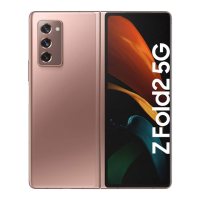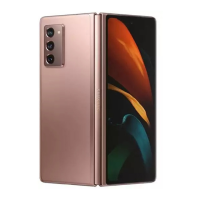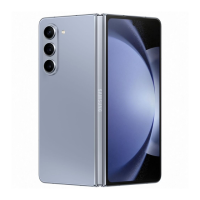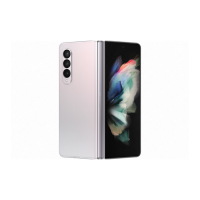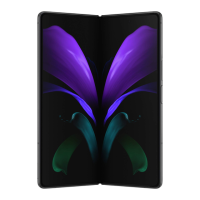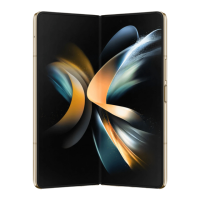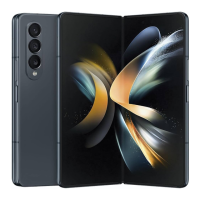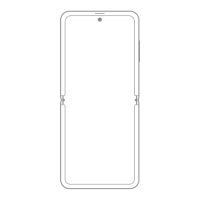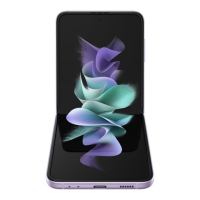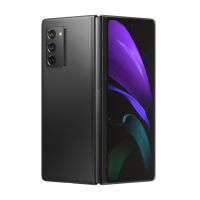
Do you have a question about the Samsung Galaxy Z Fold 2 5G and is the answer not in the manual?
| Color name | Mystic Black |
|---|---|
| Form factor | Bar |
| Product color | Black |
| Processor cores | 8 |
| Processor family | Qualcomm Snapdragon |
| Processor frequency | 3.09 GHz |
| Screen shape | Flat |
| Pixel density | 373 ppi |
| Display diagonal | 7.6 \ |
| Touchscreen type | Capacitive |
| Display resolution | 2208 x 1768 pixels |
| Second display type | Super AMOLED |
| Maximum refresh rate | 120 Hz |
| Rounded display corners | Yes |
| Second display diagonal | 6.2 \ |
| Display number of colors | 16 million colors |
| Second display resolution | 2260 x 816 pixels |
| Second display pixel density | 386 ppi |
| High Dynamic Range (HDR) technology | High Dynamic Range 10+ (HDR10 Plus) |
| RAM capacity | 12 GB |
| Compatible memory cards | - |
| Internal storage capacity | 256 GB |
| Flash type | LED |
| Optical zoom | 2 x |
| Rear camera type | Triple camera |
| Front camera type | Single camera |
| Maximum frame rate | 960 fps |
| Video recording modes | 720p, 1080p, 2160p |
| Rear camera pixel size | 1.12 µm |
| Front camera pixel size | 1.22 µm |
| Rear camera aperture number | 2.2 |
| Resolution at capture speed | 1280x720@30fps, 1280x720@960fps, 1920x1080@240fps, 1920x1080@60fps, 3840x2160@60fps |
| Third rear camera pixel size | 1 µm |
| Second rear camera pixel size | 1.8 µm |
| Video capture resolution (max) | 3840 x 2160 pixels |
| Rear camera resolution (numeric) | 12 MP |
| Front camera resolution (numeric) | 10 MP |
| Third rear camera aperture number | 2.4 |
| Second rear camera aperture number | 1.8 |
| Rear camera field of view (FOV) angle | 123 ° |
| Front camera field of view (FOV) angle | 80 ° |
| Third rear camera field of view (FOV) angle | 45 ° |
| Second rear camera field of view (FOV) angle | 83 ° |
| 4G standard | LTE |
| 3G standards | HSDPA, UMTS |
| SIM card type | NanoSIM + eSIM |
| Wi-Fi standards | 802.11a, 802.11b, 802.11g, Wi-Fi 4 (802.11n), Wi-Fi 5 (802.11ac), Wi-Fi 6 (802.11ax) |
| Bluetooth version | 5.0 |
| SIM card capability | Dual SIM |
| Mobile network generation | 5G |
| Subscription type | No subscription |
| USB connector type | USB Type-C |
| Multimedia Messaging Service (MMS) | Multimedia Messaging Service (MMS) is a standard way to send messages that include multimedia content to and from a mobile phone over a cellular network |
| Speakers | stereo |
| Audio system | Dolby Atmos |
| Audio formats supported | 3GA, AAC, AMR, APE, AWB, DFF, DSF, FLAC, IMY, M4A, MID, MIDI, MP3, MXMF, OGA, OGG, OTA, RTTTL, RTX, WAV, WMA, XMF |
| Video formats supported | 3G2, 3GP, ASF, AVI, FLV, M4V, MKV, MP4, WEBM, WMV |
| Platform | Android |
| Virtual assistant | Samsung Bixby |
| Google applications | Gmail, Google Chrome, Google Drive, Google Maps, Google Photos, Google Play, YouTube |
| App distribution platform | Google Play |
| Operating system installed | Android 10.0 |
| Talk time (3G) | - h |
| Battery capacity | 4500 mAh |
| Browsing time (Wi-Fi) | 11 h |
| Wireless audio playback time | 83 h |
| Wireless video playback time | 18 h |
| Body SAR (EU) | 1.453 W/kg |
| Head SAR (EU) | 0.859 W/kg |
| Extremities SAR (EU) | 2.89 W/kg |
| Depth | 159.2 mm |
|---|---|
| Width | 128.2 mm |
| Height | 6.9 mm |
| Weight | 282 g |
| Folded depth | 16.8 mm |
| Folded width | 68 mm |
Understand how folding the device activates special modes for enhanced usability.
Learn to capture high-resolution photos and professional-level videos with advanced settings.
Experience PC-like multitasking by connecting your device to a larger screen.
Essential safety and usage guidelines before operating the device.
Identify causes of device overheating and learn troubleshooting steps for safe operation.
Learn the proper methods for charging the device's battery safely and efficiently.
Configure settings for securing your device with various lock screen methods.
Manage applications by downloading, installing, or removing them from your device.
Learn to make and receive voice and video calls, manage contacts, and use call features.
Explore various shooting modes, settings, and techniques for capturing photos and videos.
Use your smartphone as a desktop experience by connecting to external displays or PCs.
Adjust screen settings for brightness, motion smoothness, screen mode, and more.
Secure your device using face recognition, fingerprint, and other security features.
Optimize device performance by managing battery, storage, memory, and security.
Customize system settings like language, input methods, date, time, and device reset options.
Enhance device usability with features for vision, hearing, and dexterity impairments.
Find solutions for common device issues, errors, and performance problems.
